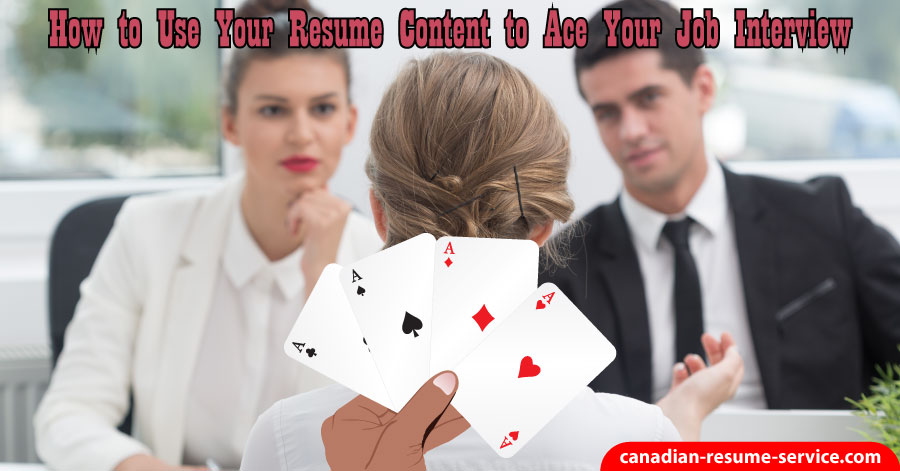If your resume content and design have landed you a job interview, you are definitely on the right path! Writing impressive targeted accomplishments within the content of your resume using a modern resume design has paid off!
Congratulations!
Your next big hurdle is the job interview phase.
Though this may seem like a frightening endeavor, it doesn’t need to be. Your resume content is the most excellent resource you can use to help you nail your job interview. If you are starting the job application process, let this point be a perfect one to remember:
If you design your resume correctly, you will not only receive a request for an interview with a hiring company but also excel during the interview.
How do I develop my resume to help me during other phases of the job application process?
Resume content should contain professional achievements, complex skill sets, and areas of expertise that make you a top-qualified job candidate to set you apart from your competition.
The first area I want to focus on is job-related accomplishments. These prove that you can execute your duties excellently while saving the company money, landing new clients, or increasing revenue. Achievements may include events like:
1. Increased sales by 20%.
2. Decreased company spending by 35%.
3. Boosted client recruitment by 23%.
Those points are impressive, but let’s make them sound even better!
We have the facts, but we need to include HOW and WHEN.
1. Increased sales by 20% over the first quarter by actively pursuing new accounts and forging positive relationships with key clients.
2. Decreased company spending by 35% by sourcing new sub-contractors and suppliers while ensuring high-quality products and services.
3. Boosted client recruitment rates by 23% from 2020 to 2021 by analyzing demographics and launching a new marketing campaign targeted toward the correct population.
Now you’re wondering, “How do I come up with these work/career achievements?”
• First, select professional accomplishments relevant to the position you are applying for. The positions do not have to be the same but require some of the same skill sets and abilities.
• Your achievements must be put into context, hence the “improved” list I provided above. The reader can understand what you did, how you did it, and over what period it occurred.
• Use as many facts or figures as possible. When you provide a hiring manager with figures or percentages, you offer them concrete and tangible numbers instead of a vague description.
• Employ the C.A.R. acronym. C.A.R. stands for Challenge, Action, and Result.
o What was the Challenge, problem, or task you faced?
o What Action did you take to remedy it?
o What was the Result?
So, how can this resume content help me during my job interview?
If you have memorized your job accomplishments, you will be set to answer questions asked in the interview – this is particularly true for a Behavioral Descriptive Interview (BDI). In this type of interview, the interviewer will say, “Tell me about a time when you had to do X.” X could represent several things: collaborating in a team, solving an almost impossible problem, dealing with a moral issue, demonstrating creativity or thinking skills, and so forth.
Use the C.A.R. method and your examples to answer these questions quickly. Try incorporating a relevant core competency into your example, demonstrating your abilities to perform the position. A core competency is any hard skill needed to do the job.
Next, discuss hard skill sets and areas of expertise to include in your resume!
Focus on incorporating your hard skills when writing your resume. Hard skills, known as tangible skills, apply specifically to the job you will be performing. For instance, if you are looking for a career in sales and marketing, hard skills may include:
Brand Design
Budget Development
Global Economy Penetration
Print and Social Media
Soft Skills Could Include:
Communication
Organization
Time management
Teamwork
and so forth
Non-tangible skills and soft skill sets can be incorporated into your resume profile and cover letter.
Hard skill sets should be highlighted in your resume profile, within your professional achievements, and in a separate section entitled “Areas of Expertise” or “Core Competencies.”
In this section, you will want to choose 8-12 areas of expertise or skills that make you an excellent job candidate. These areas may be represented in a list format or as a table. Areas of expertise should be on the first page of your resume, after your introductory paragraph or professional profile, so that readers can hone in on them immediately.
This section should incorporate hard skills relevant to the job you are applying for but may include additional traits desirable to a company and demonstrate your versatility. For instance, if we use the sales and marketing example above, you will want to include the hard skills I’ve mentioned (Brand Design, Budget Development, Global Economy Penetration, Print, and Social Media). Only use skills that genuinely apply to you and incorporate other competencies you want to showcase. These abilities could include interdepartmental relations, staff recruiting, and streamlining operations.
How can hard skills and core competencies help me during my job interview? Storytelling throughout the interview is an excellent method for building credibility and sharing accomplishments to showcase your tangible skills and abilities.
During a job interview, you must list and/or demonstrate your greatest strengths and skills that make you the best candidate. If you are not asked outright for these talents, i.e., such as during a BDI, make sure you slip them in as much as possible. Sell yourself by sharing what you have done for past employers.
Need help writing your resume content to generate interviews? How about some interview preparation to help you shine?
Check out our resume writing services or contact Candace via email or call toll-free at 1 877 738-8052.

